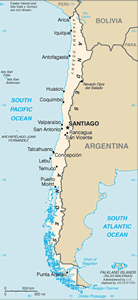The Geography of Chile
The Geography of Chile
Chilean Geography
Location: Southern South America, bordering the South Pacific Ocean, between Argentina and Peru
Geographic coordinates: 30 00 S, 71 00 W
Map references: South America
Area: total: 756,950 sq km land: 748,800 sq km water: 8,150 sq km note: includes Easter Island (Isla de Pascua) and Isla Sala y Gomez
Area - comparative: slightly smaller than twice the size of Montana
Land boundaries: total: 6,339 km border countries: Argentina 5,308 km, Bolivia 860 km, Peru 171 km
Coastline: 6,435 km
Maritime claims: territorial sea: 12 nm contiguous zone: 24 nm exclusive economic zone: 200 nm continental shelf: 200/350 nm
Climate: temperate; desert in north; Mediterranean in central region; cool and damp in south
Terrain: low coastal mountains; fertile central valley; rugged Andes in east
Elevation extremes: lowest point: Pacific Ocean 0 m highest point: Nevado Ojos del Salado 6,880 m
Natural resources: copper, timber, iron ore, nitrates, precious metals, molybdenum, hydropower
Land use: arable land: 2.62% permanent crops: 0.43% other: 96.95% (2005)
Irrigated land: 19,000 sq km (2003)
Natural hazards: severe earthquakes; active volcanism; tsunamis
Environment - current issues: widespread deforestation and mining threaten natural resources; air pollution from industrial and vehicle emissions; water pollution from raw sewage
Environment - international agreements: party to: Antarctic-Environmental Protocol, Antarctic-Marine Living Resources, Antarctic Seals, Antarctic Treaty, Biodiversity, Climate Change, Climate Change-Kyoto Protocol, Desertification, Endangered Species, Environmental Modification, Hazardous Wastes, Law of the Sea, Marine Dumping, Ozone Layer Protection, Ship Pollution, Wetlands, Whaling signed, but not ratified: none of the selected agreements
Geography - note: strategic location relative to sea lanes between Atlantic and Pacific Oceans (Strait of Magellan, Beagle Channel, Drake Passage); Atacama Desert is one of world's driest regions


